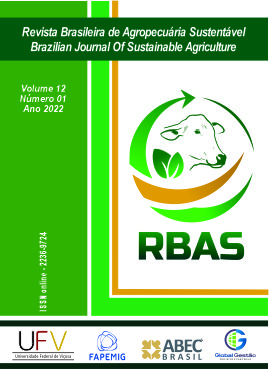ADJUSTING THE OPTIMAL ARRANGEMENT OF PLANTS TO MAXIMIZE THE PRODUCTIVITY AND QUALITY OF FLAXSEED GRAINS
DOI:
https://doi.org/10.21206/rbas.v12i1.14242Keywords:
Linum usitatissimum, dissimilarity, linear correlation.Abstract
The aim of this work was to highlight the effects of row spacing and seed densities on the agronomic performance of flaxseed. The trial was developed in the experimental area of the Regional Institute of Rural Development, which belongs to the Regional University of the Northwest of the Brazilian State of Rio Grande do Sul. The experimental design was randomized blocks, and the treatments were structured in factorial scheme three (spacings) x six (densities) with three replications per treatment, totaling 54 experimental units. We used three spacings between rows, 18 cm, 36 cm and 54 cm, and densities of 30, 60, 90, 120, 150 and 180 seeds per linear meter. The experimental units were three meters wide by 10 meters long, totaling 30 square meters. Morphological and productive variables of the flaxseed crop were evaluated, as well as meteorological variables. Increased spacing contributes to reduced grain yield regardless of the sowing density. The row spacing of 18 cm shows the best results for grain yield in relation to the seed densities used. High magnitude linear associations such as number of stem branches, productive branches, number and mass of capsules and grains per plant, and plant population define grain yield per unit of area.
Downloads
Downloads
Published
How to Cite
Issue
Section
License
Copyright (c) 2022 Brazilian Journal of Sustainable Agriculture

This work is licensed under a Creative Commons Attribution-NonCommercial-NoDerivatives 4.0 International License.
1. Proposta de Política para Periódicos de Acesso Livre
Autores que publicam nesta revista concordam com os seguintes termos:
Autores mantém os direitos autorais e concedem à revista o direito de primeira publicação, com o trabalho simultaneamente licenciado sob a Licença Creative Commons Attribution que permite o compartilhamento do trabalho com reconhecimento da autoria e publicação inicial nesta revista.












